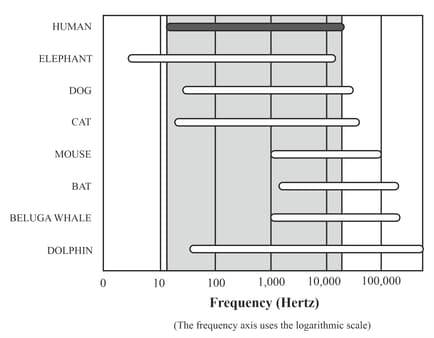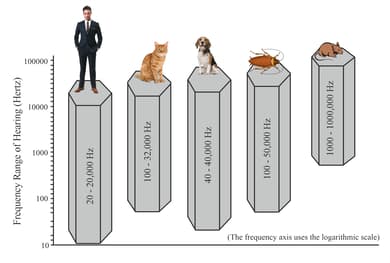Study the graphic depicting the range of frequencies different animals can hear. Which of the options correctly depicts the animals having the highest audible range of frequencies?

Note that the horizontal scale is not a linear scale.

Dolphin, Beluga Whale, Bat

Important Questions on Sound
The sound wave is a longitudinal wave. Longitudinal waves are those waves in which the particles of the medium vibrate parallel or antiparallel along the direction of propagation of the wave. The longitudinal wave travels with the formation of 'rarefactions' and 'compressions'. Compression is the part of the wave in which the particles of the medium are closer than they normally are. Here, the density of the medium is more than the normal density and volume decreases momentarily. Rarefaction is that part of the wave in which the particles of the medium are farther apart than they normally are. Here, the density of the medium is less than the normal density and the volume increases momentarily.
In the figure given, compared to wave P, wave Q would be _____.

Earlier, remote control devices used a particular range of frequency. This range was withdrawn because these frequencies were heard by dogs, though not by human beings. Which of the following frequency ranges would have been earlier used in a remote control device?

The frequency range in which some common animals can hear is shown in the graphic below. A manufacturer wants to create a pest controller that will emit loud sounds that can be heard by insects and rodents (and will hence drive them away), but will not affect humans and pets. What frequencies of sound should the pest controller produce?

An astronaut is moving in space when a big explosion occurs about a hundred meters behind him. How will the astronaut come to know about the explosion?

The unit used for measuring the intensity of sound is decibel. The faintest sound that the human ear can detect is assigned a value of 0 decibels. Study this table and answer the question. Study this table and answer the question. Which of these could be the decibel level during a severe thunderstorm?
| Decibel | Example | Maximum safe exposure |
| 0 | the quietest sound that you can hear | (Safe) |
| 30 | whisper, quiet library | (Safe) |
| 60 | normal conversation, sewing machine, typewriter | (Safe) |
| 90 | tools in a workshop, truck traffic | 8 hours per day |
| 100 | Chainsaw, pneumatic drill | 2 hours per day |
| 115 | sandblasting, loud rock concert, auto horn | 15 minutes per day |
| 140 | loud gunshot, jet engine: noise causes pain and may injure unprotected ears | Maximum allowed noise with a hearing protector |
